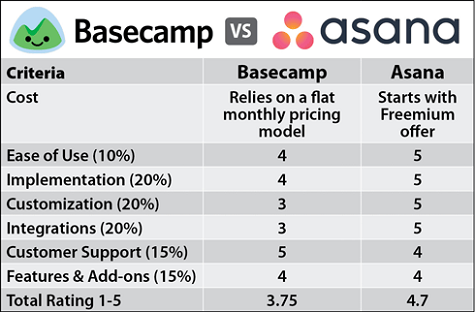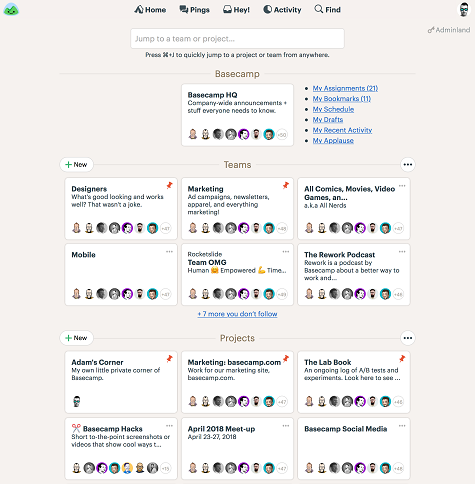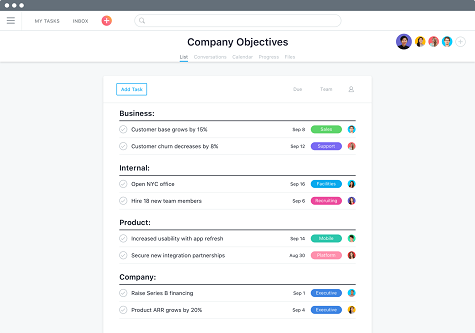With now over three million user accounts, Basecamp has redefined collaboration with a suite of web-based project management applications. But as a new generation of so-called cloud native project management applications has started to emerge in the form of software-as-a-service (SaaS) applications such as Asana, expectations are starting to change.
Asana provides an intuitive graphical interface for accessing a broad range of project management capabilities that are easily integrated with third-party collaboration services such as Slack. In contrast, Basecamp assumes that most users are going to spend most of their working day within its suite of web applications. The challenge that creates for project managers is that most of the people they are trying to manage are spending more of their working day in applications such as Slack or Microsoft Teams.
Depending on the biases and preferences of the end user, either Basecamp or Asana are up to the project management task. But it’s worth noting that Basecamp has not seen a major upgrade since 2014, so in terms of modern application experience, Asana has a significant edge. The issue is that given the flat pricing model favored by Basecamp, the cost of using Asana on a per-user basis, per month, can easily wind up being a lot higher.
It’s not clear how many Basecamp users might be enticed to switch to a more modern application experience in the form of Asana that is, for example, a lot more mobile computing friendly. But given the fact that there are still millions of users relying on spreadsheets and email to manage projects, there should be plenty of room for both companies to gain converts for years to come.
What are the Similarities & Differences between Asana and Basecamp?
Asana and Basecamp employ fundamentally different approaches to managing projects. Asana organizes projects around a series of tasks that need to be managed by a team of people working on the elements that make up a project. Basecamp presents end users with access to multiple projects that they can then drill down into by clicking their way through a series of menus. Basecamp is essentially designed to meet the requirements of individuals who have to regularly manage many projects, while Asana is designed with more of a team sport approach to managing a specific project.
Basecamp also includes a series of capabilities not found in Asana, including a text editor for updating documents and a means to manage version control as those documents are updated.
Overall, Basecamp has more capabilities than Asana and may appeal more to individuals who need to juggle many projects at once. However, the one critical capability that Asana does provide support for more deeply is the ability to generate reports and apply analytics to determine whether any given project will meet a deadline.
Cost
Assuming the number of members of your team exceeds 10, the cost of Basecamp is hard to beat. Basecamp charges a flat $99 per month for the entire team. Asana makes available a freemium version of its software, but charges $9.99/user/month for an annual contract for a premium edition, and $19.99/user/month for a business edition. Slightly higher-priced options of Asana are available for customers that don’t want to commit to an annual contract. Once you get over 10 users, the cost of Asana starts to exceed Basecamp.
Basecamp also notes that its approach can eliminate the need for separate collaboration, calendaring and cloud storage services.
Ease of Use
Basecamp User Experience
Asana User Experience
Asana is a modern application that makes extensive use of a visual drag-and-drop interface that can access a SaaS application from any device.
Basecamp is a much more traditional web-based application designed to be accessed via a browser. As such, support for mobile computing devices is much more limited.
Implementation
Asana is a modern SaaS application designed to be accessible to the average end user in a matter of minutes. Basecamp is more of a suite of complementary web applications that require a lot more time to configure.
Customization
Asana provides access to a series of templates and fields that can be easily customized.
Basecamp provides access to a toolbox that enables users to turn on and off specific functions as they see fit.
Integrations
Asana makes it relatively simple to access third-party functionality by simply dragging and dropping plug-ins for applications such as Slack or Microsoft Teams right into the application.
Basecamp assumes project teams have little need to integrate with external applications because all the functionality required is baked into the platform. On a practical level, however, most organizations are employing a plethora of communications tools to deliver updates in addition to relying on cloud services to share documents.
Customer Support
Basecamp provides customer support as part of its flat fee model and the company has created a passionate community that provides mutual support as well as tips to one another.
Asana provides support once organizations start licensing its software in a way that is consistent with any SaaS application platform.
Features & Add-ons
Basecamp assumes that all features any project manager should require are baked into the platform, so in terms of capabilities, Basecamp is a little richer.
Because Asana assumes the project management application will be integrated with other platforms, the add-ons built on top of the application programming interfaces (APIs) it exposes feel much more like a natural extension of the platform.
How to decide which is Best for Your Situation
Basecamp undoubtedly includes many capabilities that some project leaders are going to prefer to be able to access from within the same application. In many ways, Basecamp is as much about a philosophy toward managing projects as it is an application. The company co-founders are widely known for their resolute commitment to maintaining the 40-hour work week.
Asana reflects more Silicon Valley sensibilities as it relates to working more flexibly from anywhere at any time. The goal is to clearly accomplish more goals faster by optimizing the schedules of all the members of a team. That approach may appeal more to, for example, an owner of a business rather than a project leader trying to track multiple projects simultaneously over an extended time period.
Ultimately, the choice between Asana and Basecamp may say a lot more about the person making the selection than it does the application. Both project management approaches will enable anyone to get the job done. The issue is what tradeoffs project managers are likely to want to make to gain access to a more modern application that may not have every bell and whistle that they currently rely on embedded within the application itself.






